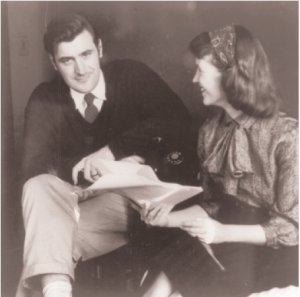|
 The Grolier Club of New York opens a major exhibition Sept. 14 devoted to two of the 20th century's most celebrated poets. "'No Other Appetite': Sylvia Plath, Ted Hughes and the Blood Jet of Poetry" brings together for the first time original letters, manuscripts and photographs from the Sylvia Plath archive at Smith College and from the Ted Hughes archive at Emory University. The exhibition documents the close creative relationship of these two poets during the years of their marriage and the repercussions of Plath's tragic suicide in the life and work of her husband, the late poet laureate of Britain. The Grolier Club of New York opens a major exhibition Sept. 14 devoted to two of the 20th century's most celebrated poets. "'No Other Appetite': Sylvia Plath, Ted Hughes and the Blood Jet of Poetry" brings together for the first time original letters, manuscripts and photographs from the Sylvia Plath archive at Smith College and from the Ted Hughes archive at Emory University. The exhibition documents the close creative relationship of these two poets during the years of their marriage and the repercussions of Plath's tragic suicide in the life and work of her husband, the late poet laureate of Britain.
The exhibition, co-curated by Smith's Karen Kukil and Emory's Steve Enniss, includes materials drawn from a number of recently acquired collections that have never before been exhibited to the public. Included are family letters and photographs, manuscripts of the poets' work -- sometimes with writing by each on opposite sides of the same page -- as well as books from the two poets' personal libraries that have been heavily annotated in their hands.
Among the highpoints of the exhibition is a selection of notes and typescripts for Plath's unpublished novel Falcon Yard. This autobiographical novel, described in Plath's notes as "a fable of faithfulness," recounts the story of her and Hughes' courtship and marriage. One of Plath's early biographers doubted the existence of such a manuscript altogether. More recently Plath was thought to have destroyed the entire manuscript when she learned of Hughes' affair with Assia Wevill. The notes and typescripts included in this exhibition -- part of a larger selection of manuscript fragments of the novel in the Emory collection -- escaped destruction because of the couple's habit of composing new work on discarded manuscript pages of one another's work. These surviving fragments cast light on Plath's conception of this previously lost novel.
Also present in the exhibition are a number of books owned by Hughes and Plath that have never before been seen by the public. The copy of Ernest Jones' study of dreams, On the Nightmare, which Plath inscribed for Hughes their first Christmas together, is included, as is Plath's heavily underscored and annotated copy of Virginia Woolf's To the Lighthouse. One of the most moving books present in the exhibition is the copy of Erich Fromm's The Art of Loving, which Plath read on the advice of her analyst in the final weeks of her life. This heavily underscored text offers readers a glimpse of Plath trying to come to terms with her own failed marriage in the weeks leading up to her suicide, weeks during which she also composed the poems that would insure her posthumous fame.
Equally illuminating are letters and manuscripts in Hughes' hand that reflect the hurt and guilt he felt in the years following Plath's death. In a badly-worn notebook dating from the late 1960s, Hughes records a dream in which Plath comes back to life for one day. After the subsequent suicide of Wevill in 1969, Hughes writes to a friend and confides, "I wonder sometimes if things might have gone differently without the events of 63 & 69. I have an idea of those two episodes as giant steel doors shutting down over great parts of myself-leaving me that much less, just what was left, to live on. No doubt a more resolute artist would have penetrated the steel doors." In an undated manuscript Hughes confesses that he writes poetry in hope of some catharsis: "I am not composing poetry," he writes, "I am trying to get out of the flames."
In a letter to fellow poet Seamus Heaney written shortly before his own death Hughes explains his decision to write the autobiographical sequence of poems, "Birthday Letters," about his marriage to Plath. "I'd come to the point where there seemed no alternative," he writes. He first published a small number of poems about Plath in his "New Selected," but "the rest I stuffed back into the sack. But they wouldn't stay."
"So I brought them back up & wrote at them en masse for some time-not knowing what I'd end up with or where I'd end. Till suddenly -- between one day & the next -- I realized that was it. I couldn't grasp the wholeness of it but I had the sensation of the whole load of long preoccupation dropping away -- separating itself and dropping away like a complete piece of fruit. The sense of being released from it very strong and very weird."
This selection of documents from the Plath and Hughes archives will give readers of these poets' work an intimate glimpse of the shared life of two of the last century's major poetic voices.
LOCATION AND TIMES: 'No Other Appetite' will be on view at the Grolier Club from Sept. 14-Nov. 19, 2005, with the exception of Oct. 10, Columbus Day. Hours: Monday-Saturday 10 AM - 5 PM. Open to the public free of charge. An illustrated catalogue of the exhibition (hardcover, 6 x 9, 84 pp., 27 illustrations, $35) will be available from The University Press of New England (UPNE). Copies may also be purchased at the Grolier Club (47 East 60th Street, between Park and Madison Avenues) in New York City during exhibition hours.
For more information e-mail Megan Smith at the Grolier Club.
|